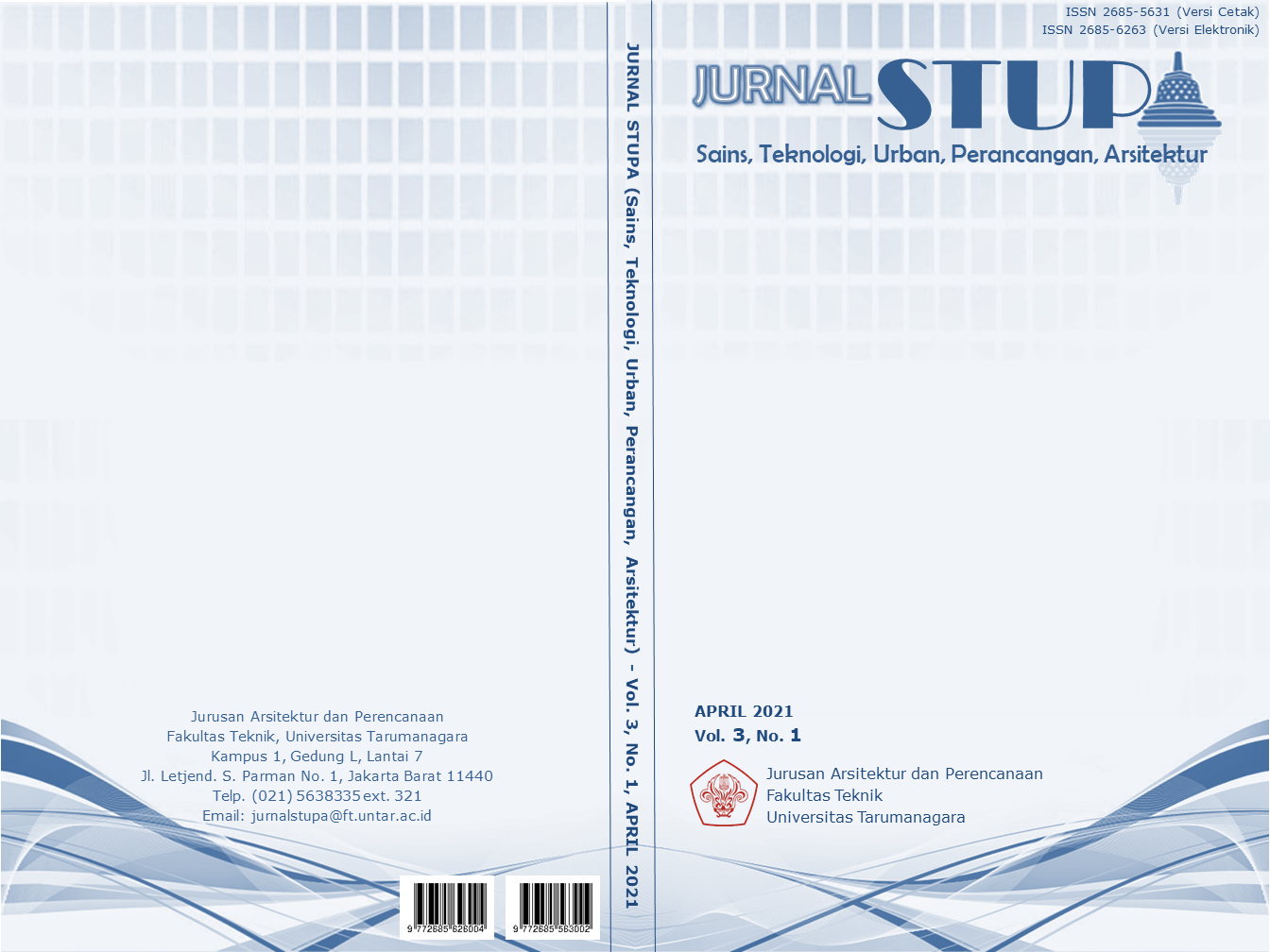SOEDOET TEMU TJIPINANG
Main Article Content
Abstract
The Covid-19 pandemic has a major impact on the entire population, especially in Indonesia. These changes gave birth to big jumps in terms of economy, health and social. This is due to new lifestyles such as physical distancing and work from home. The new normal condition creates a lot of spaces, both outdoor and indoor, which are temporarily closed until an indefinite time. The order to fulfill the community's creativity forum through the implementation of health protocols which is increasingly tightened to limit the movement of activities of the community, with the aim of reducing the level of spread of the virus. People who are born as social beings feel restlessness, anxiety, stress and so on. One of these problems occurs in the Cipinang area where due to limited space for the surrounding community, it requires a forum that is able to collaborate in a pandemic and meet the needs of its users. This space that prioritizes health, both physically, mentally and physically, is complemented by several main daily functions at this time, namely studying and working. The application of new methods in building and working, namely the co-working area in the form of a cubicle. In addition, there are other supporting activities such as entertainment on the screen step on the temporary space. Clinic exists as a fulfillment in balancing the dense activities of today's society ranging from the elderly to children.
Keywords: Cipinang; Covid-19; Communal
Abstrak
Pandemi covid-19 memberikan dampak besar bagi seluruh penduduk khususnya di Indonesia. Perubahan tersebut melahirkan lonjakan besar baik dari segi ekonomi, kesehatan maupun sosial. Hal tersebut dikarenakan adanya gaya hidup baru seperti physical distancing dan work from home. Kondisi new normal, menciptakan banyak ruang-ruang baik outdoor maupun indoor ditutup sementara hingga waktu yang masih belum bisa ditentukan. Tatanan pemenuhan wadah kreativitas masyarakat melalui penerapan protokol kesehatan yang kian diperketat membuat terbatasnya gerak aktivitas dari masyarakat, dengan maksud dalam mengurangi tingkat penyebaran virus. Masyarakat yang sejak lahir memiliki sifat sebagai makhluk sosial merasakan kegelisahan, cemas, stress dan sebagainya. Permasalahan ini salah satunya terjadi di kawasan Cipinang dimana akibat terbatasnya ruang gerak bagi masyarakat sekitar sehingga membutuhkan wadah yang mampu berkolaborasi dalam pandemic serta memenuhi kebutuhan penggunanya. Ruang yang mengedepankan kesehatan baik secara fisik, jiwa maupun raga dari tiap orangnya ini dilengkapi oleh beberapa fungsi utama keseharian saat ini yaitu belajar maupun bekerja. Penerapan cara baru dalam bangunan maupun bekerja yaitu co-working area dalam bentuk cubicle. Selain itu adapun aktivitas pendukung lainnya seperti hiburan layar tancap pada temporary space. Clinic hadir sebagai pemenuhan dalam menyeimbangkan padatnya kegiatan masyarakat jaman sekarang mulai dari lansia hingga anak-anak.
Article Details
References
Carteau, M. (1998). The practice of everyday life. Berkeley : University of California Press
Cloke, P. Jones, O. (2001). Dwelling, place, and landscape: an orchard in somerset. Journal of Planning Literature, 16(2). 236-319
Cuba, L. (1993). A place to call home: Identification with dwelling, community, and region. The Sociological Quarterly, 34(1). 111-131
Ellie, S. (2020). Architecture seeks designs for a post-pandemic world, diakses dari https://www.wallpaper.com/architecture/global-post-pandemic-architecture-responses
Hardy, SE. Concato, J. (2004). Resilience of community – dwelling older persons. Journal of the American Geriatrics Society, 52(2). 257-262
Heidegger, M. (1999). Building Dwelling Thinking. In David Farrell Krell (Ed.), Basic Writings Martin Heidegger (pp. 347-363). London: Routledge.
Ingold, T. (2000). The perception of the environment. Birmingham : Centre for Urban and Regional Studies, Univ. of Birmingham
Kim, T. (2020). How architecture could help us adapt to the pandemic, diakses dari https://www.wallpaper.com/architecture/global-post-pandemic-architecture-responses
Kyle, C. (2020). How the corona virus will reshape architecture, diakses dari https://www.wallpaper.com/architecture/global-post-pandemic-architecture-responses
McFarlane, C. (2011). The city as assemblage: dwelling and urban space. Environment and planning : society and space. 29 (4), 649-671
Michael, M. (2020). The role of architecture in fighting a pandemic, diakses dari https://www.bostonglobe.com/2020/04/06/opinion/role-architecture-fighting-pandemic/
Philip, K. (2020). Designing to survive, diakses dari https://www.wallpaper.com/architecture/global-post-pandemic-architecture-responses
William, J. (2020). Architecture is a critical ingredient of pandemic medicine, diakses dari https://www.architectmagazine.com/practice/architecture-is-a-critical-ingredient-of-pandemic-medicine_o



